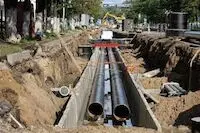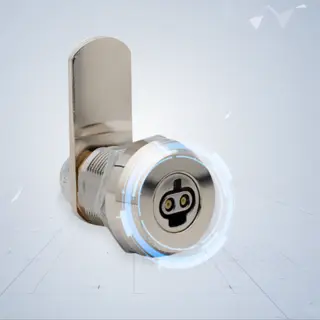Intelligent Trenchless Repair Technology for Municipal Drainage Pipelines
Abstract: This article examines the research and intelligent applications of trenchless repair technology for municipal drainage pipelines. After reviewing several common repair technologies, the article analyzes their application process from three key aspects: repair methods, pipeline diversion schemes, and desilting operations. The article also highlights the role of intelligent detection and smart operation and maintenance. This integrated approach maximizes the value of trenchless technology in municipal drainage systems while significantly improving the efficiency and quality of pipeline repair.
1. Introduction
With rapid urbanization, expanding city scales, and growing populations, traditional drainage systems face increasing challenges such as insufficient capacity and aging pipelines. These issues significantly reduce drainage efficiency and disrupt residents’ daily lives. To address them, trenchless repair technology has emerged as an effective and practical solution. It enables efficient underground pipe repair without disrupting urban traffic, meeting the needs of drainage system renewal while supporting sustainable urban infrastructure. Today, trenchless repair technology is evolving toward greater intelligence. By integrating sensor technology, real-time data transmission, and intelligent monitoring, trenchless repair enables continuous assessment of pipeline conditions, ensures precise and timely interventions, and safeguards the reliable operation of municipal drainage systems.
2. Analysis of Common Trenchless Repair Technologies for Municipal Drainage Pipes
Municipal drainage pipelines play a vital role in transporting rainwater, sewage, and other wastewater. However, with accelerating urbanization, pipe aging and structural damage have become more common, leading to the growing use of trenchless repair technologies. Several common methods are used for municipal drainage pipe repair:
In-situ Curing
In-situ curing involves inserting a resin-impregnated liner into the damaged pipe, which is then cured using hot water, steam, or ultraviolet light to form a new internal lining. In-situ curing is fast, durable, and high-quality, particularly suitable for long, large-diameter pipes, preventing secondary leaks and prolonging service life.
Spiral Wound Lining
Spiral wound lining involves spirally inserting specially engineered PE or PVC strips inside the existing pipe to create a new internal lining. It effectively restores damaged pipes, smooths the inner walls, and significantly enhances hydraulic performance and drainage capacity. The process is straightforward and adaptable to a wide variety of pipe conditions.
Pipe Insertion
This method installs a new pipe—or a liner pipe—inside the existing pipeline using trenchless techniques such as jacking or directional drilling. Depending on the situation, it can be performed as either continuous pipe insertion for long-distance repairs or short-pipe insertion for localized or short-length sections. Continuous insertion is ideal for long-distance, large-diameter pipelines, whereas short-pipe insertion is better suited for localized damage or shorter sections. This technology minimizes environmental impact during construction while ensuring long-term durability.
3. Current Applications of Intelligent Technology in Trenchless Municipal Drainage Pipeline Repair
3.1 Pipeline Inspection
Pipeline inspection, as the initial stage of trenchless municipal drainage repair, is intended to quickly and accurately detect internal defects, ensuring that subsequent rehabilitation proceeds smoothly. With ongoing advances in science and technology, inspection methods have seen significant development. Currently, the techniques most widely employed in the industry include closed-circuit television (CCTV), sonar, and laser scanning. CCTV inspection utilizes high-definition cameras and lighting equipment to transmit real-time images of the pipeline interior to a ground-based control room. Operators can monitor internal conditions, document the location and extent of defects, and evaluate the overall condition of the pipeline. With its intuitive operation and high accuracy, CCTV inspection is especially effective for detecting cracks, corrosion, and other structural defects, enabling engineers to formulate comprehensive repair plans. Sonar inspection relies on the emission and propagation of sound waves within the pipeline. It provides strong penetration and wide applicability, enabling the detection of hidden defects such as cavities and deformations. Sonar inspection is particularly valuable in situations where CCTV inspection is not feasible—for instance, when groundwater levels are high or the pipeline is filled with water.
3.2 Defect Assessment
In trenchless rehabilitation, defect assessment is a crucial process that provides detailed information for formulating effective and comprehensive repair plans. The primary technologies currently employed for defect assessment include the following:
Big Data Analysis
In municipal drainage pipeline inspections, big data analysis can identify patterns and detect hidden defects with greater accuracy and depth. By incorporating factors such as the operating environment and pipeline age, this approach enables inspectors to more accurately assess both the severity of existing defects and potential future deterioration trends. This ensures that repair plans are not only targeted but also practical and sustainable.
Machine LeaMachine Learning Algorithms
Machine learning algorithms utilize historical defect data to train and construct predictive models. These models can automatically classify defect types and assess their severity in real time, significantly improving both the accuracy and efficiency of the evaluation process.
Virtual Reality Virtual Reality (VR) Technology
VR technology simulates the internal environment of pipelines and provides three-dimensional visualization of defect conditions. This immersive approach enables inspectors to intuitively observe and analyze defects, thereby enhancing both the accuracy and reliability of their assessments.
3.3 Repair Plan Development
Developing a comprehensive repair plan is essential for the rational selection of suitable repair materials and for ensuring the normal operation of pipelines. Intelligent optimization algorithms, inspired by natural processes, can iteratively adjust parameter combinations to identify the optimal solution that satisfies performance objectives. In trenchless repair planning for municipal drainage pipelines, these algorithms are primarily used to optimize the selection of repair technologies and materials. Specifically, intelligent optimization algorithms integrate criteria such as repair cost, construction duration, and repair effectiveness. Through multi-objective optimization, they automatically determine the most feasible repair plan based on the severity, location, and material of existing pipeline defects. This approach significantly reduces manual intervention and enables the development of a more scientific and precise repair plan. Moreover, in practice, intelligent optimization algorithms can dynamically modify repair plan details based on real-time feedback from construction parameters. If substandard repair material performance or equipment failure occurs during construction, the algorithm can promptly revise the plan, select alternative materials, and optimize work processes, thereby ensuring the efficient execution of subsequent repair operations.
4. Intelligent Application Paths for Trenchless Repair Technology in Municipal Drainage Pipelines
4.1 Intelligent Detection
Intelligent detection technology plays a crucial role in the trenchless repair of municipal drainage pipelines by improving inspection accuracy, optimizing repair plan details, and facilitating efficient monitoring. By deploying sensors inside and around pipelines, intelligent sensor networks can monitor pipeline operations in real time, enabling personnel to promptly identify and address potential issues. In practice, pipeline characteristics are first evaluated to select suitable flow, pressure, and water quality sensors according to monitoring requirements. These sensors collect real-time operational data—such as flow rate, pressure, and water quality—and transmit it to a data processing center through wired or wireless channels. On-site personnel then analyze the data using specialized software to assess whether the pipeline is operating abnormally. If sudden flow changes, abnormal pressure, or water quality deviations are detected, the system promptly issues an alarm, prompting the formulation of a rapid remedial plan. Personnel can also access the remote monitoring platform at any time to review operational status, integrate data trends and early warning alerts, and refine repair strategies, thereby providing accurate data support for decision-making. Additionally, a combined “air-ground” inspection approach can be employed: drones capture terrain images, robots equipped with cameras traverse pipelines to record footage, and radar scans subsurface structures. AI systems onboard the robots automatically detect issues such as cracks and deformations with an accuracy exceeding 95%, and a 3D map is generated with color-coded indicators representing the severity of the detected problems.
4.2 Intelligent Decision-Making
Computer systems automatically generate recommended repair options based on inspection data. By inputting information such as pipe material and the location of damage, the system selects the most suitable repair method from standard techniques. For instance, resin repairs may be recommended for localized damage, whereas pipe lining is applied for extensive damage. The system also estimates the cost and expected duration for each option, thereby supporting informed decision-making.
4.3 Intelligent Construction
During repairs, construction personnel can utilize AR glasses that display a 3D representation of the pipeline, highlighting areas that require cutting or installation. Construction robots can autonomously perform lining installation and curing. For example, using the in-situ curing method, a robot can repair 20 meters of pipeline per hour while simultaneously monitoring curing temperature and pressure to ensure compliance with quality standards. The system can also autonomously adjust parameters under complex conditions, such as reducing drawing speed when a pipe bend is detected.
4.4 Intelligent Operation and Maintenance
In operation and maintenance management, establishing an intelligent closed-loop system encompassing perception, analysis, decision-making, and execution enables comprehensive lifecycle management of pipeline health. A micro-sensor matrix is deployed at key nodes along the repaired pipeline to enable continuous, all-weather monitoring of the system. By analyzing the monitoring data, potential operational issues can be promptly identified, enabling personnel to formulate targeted repair plans efficiently and ensure the effective operation of the drainage network. The sensor network also supports self-organizing capabilities, automatically rerouting communications if a node fails, thereby maintaining uninterrupted data collection. A pipeline health assessment model based on machine learning is employed to automatically detect abnormal patterns. For instance, cluster analysis may reveal that a sudden drop in flow indicates a blockage, while a time-series model predicts the progression of structural defects. A three-dimensional emergency command system, integrating BIM and GIS technologies, enables intelligent management of the entire process—from fault detection to resolution. When an early warning is triggered, the system automatically retrieves data on underground pipelines within a 500-meter radius of the fault. Using traffic and other relevant data, the system generates the optimal repair route and selects the most efficient solution by evaluating the time and cost of different repair methods. For instance, a 5.2-kilometer drainage pipeline in a commercial complex had been neglected for an extended period, resulting in numerous leaks and reduced drainage efficiency. Using intelligent trenchless repair technology, initial inspections identified 136 damage points, mainly corrosion and cracks. UV-curable lining technology was applied, in which a UV-curable resin lining is installed inside the old pipe to form a smooth new inner wall, enhancing durability and drainage efficiency. The repaired pipeline is continuously monitored through the integration of GIS data, real-time measurements, and historical maintenance records. Flow and pressure are monitored around the clock, with potential issues addressed promptly based on preset thresholds. Following the repair, the pipeline’s flow rate increased by 20%, while the leakage rate was reduced to below 0.3% compared to pre-repair performance.
5. Conclusion
In conclusion, advances in intelligent technology have revolutionized trenchless repair of municipal drainage pipelines. Through advanced detection, analysis, and construction techniques, defects can be accurately identified, and comprehensive repair plans can be rapidly implemented. The use of intelligent construction equipment has significantly enhanced repair efficiency, effectively supporting the sustainable and healthy development of urban drainage systems.
Send your message to this supplier
Related Articles from the Supplier
Related Articles from China Manufacturers
The Development Prospect of Intelligent Door Lock
- Mar 10, 2016
Intelligent ATM Lock Solution Made by Make
- Oct 05, 2023
Intelligent Security Upgrade of Safes
- Dec 21, 2023
Related Products Mentioned in the Article
XIAMEN LANDEE INDUSTRIES CO., LTD.
- https://www.landee.cn/
- Address: NO. 321 JIAHE ROAD, XIAMEN, P.R.CHINA 361012
- Phone: 86-592-5204188
- Business Type: Trading, Manufacturer,
Supplier Website
Source: https://www.landeepipe.com/intelligent-trenchless-repair-technology-for-municipal-drainage-pipelines.html







